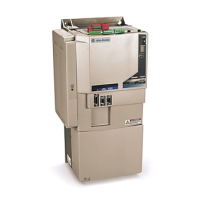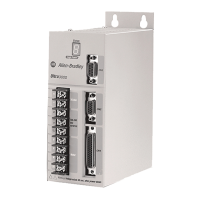Rockwell Automation Publication 2094-UM001J-EN-P - March 2017 175
Troubleshooting the Kinetix 6000 Drive System Chapter 7
General System Anomalies
These anomalies do not always result in a fault code, but can require
troubleshooting to improve performance.
Table 111 - General System Anomalies
Condition Potential Cause Possible Resolution
Axis or system is unstable.
The position feedback device is incorrect or open. Check wiring.
Unintentionally in Torque mode.
Check to see what primary operation mode was
programmed.
Motor tuning limits are set too high. Run Tune in the Logix Designer application.
Position loop gain or position controller acceleration or deceleration rate is
improperly set.
Run Tune in the Logix Designer application.
Improper grounding or shielding techniques are causing noise to be
transmitted into the position feedback or velocity command lines, causing
erratic axis movement.
Check wiring and ground.
Motor Select limit is incorrectly set (servo motor is not matched to axis
module).
•Check setups.
• Run Tune in the Logix Designer application.
Mechanical resonance.
Notch filter or output filter can be required (refer to Axis
Properties dialog box, Output tab in the Logix Designer
application).
You cannot obtain the motor
acceleration/deceleration that you
want.
Torque Limit limits are set too low. Verify that current limits are set properly.
Incorrect motor selected in configuration.
Select the correct motor and run Tune in the Logix
Designer application again.
The system inertia is excessive.
• Check motor size versus application need.
• Review servo system sizing.
The system friction torque is excessive. Check motor size versus application need.
Available current is insufficient to supply the correct acceleration or
deceleration rate.
• Check motor size versus application need.
• Review servo system sizing.
Acceleration limit is incorrect. Verify limit settings and correct them, as necessary.
Velocity Limit limits are incorrect. Verify limit settings and correct them, as necessary.
Motor does not respond to a velocity
command.
The axis cannot be enabled for 1.5 seconds after disabling.
Disable the axis, wait for 1.5 seconds, and enable the
axis.
Enable signal has not been applied or the enable wiring is incorrect.
•Check the controller.
• Check the wiring.
The motor wiring is open. Check the wiring.
The motor thermal switch has tripped.
• Check for a fault.
• Check the wiring.
The motor has malfunctioned. Repair or replace the motor.
The coupling between motor and machine has broken (for example, the motor
moves, but the load/machine does not).
Check and correct the mechanics.
Primary operation mode is set incorrectly. Check and properly set the limit.
Velocity or current limits are set incorrectly. Check and properly set the limits.
Presence of noise on command or
motor feedback signal wires.
Recommended grounding per installation instructions have not been
followed.
•Verify grounding.
• Route wire away from noise sources.
• Refer to System Design for Control of Electrical
Noise, publication GMC-RM001
.
Line frequency present.
•Verify grounding.
• Route wire away from noise sources.
Variable frequency can be velocity feedback ripple or a disturbance caused by
gear teeth or ballscrew balls, for example. The frequency can be a multiple of
the motor power transmission components or ballscrew speeds resulting in
velocity disturbance.
• Decouple the motor for verification.
• Check and improve mechanical performance, for
example, the gearbox or ballscrew mechanism.

